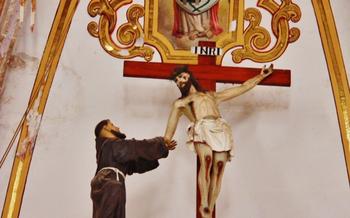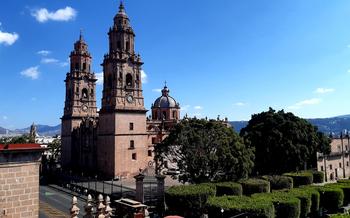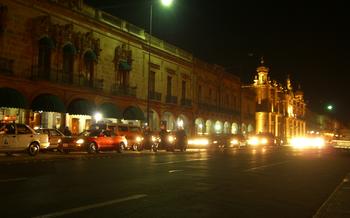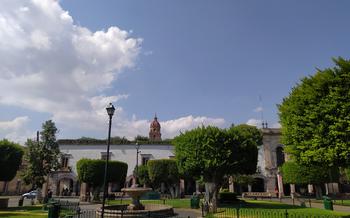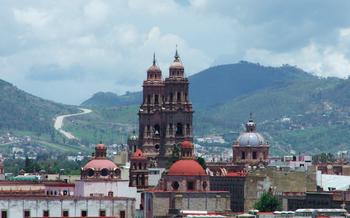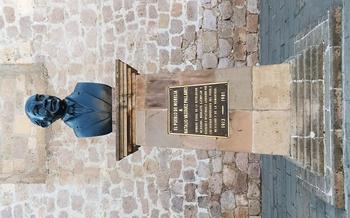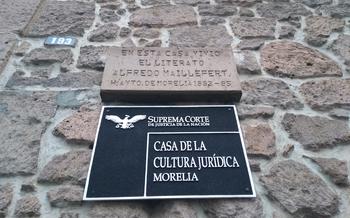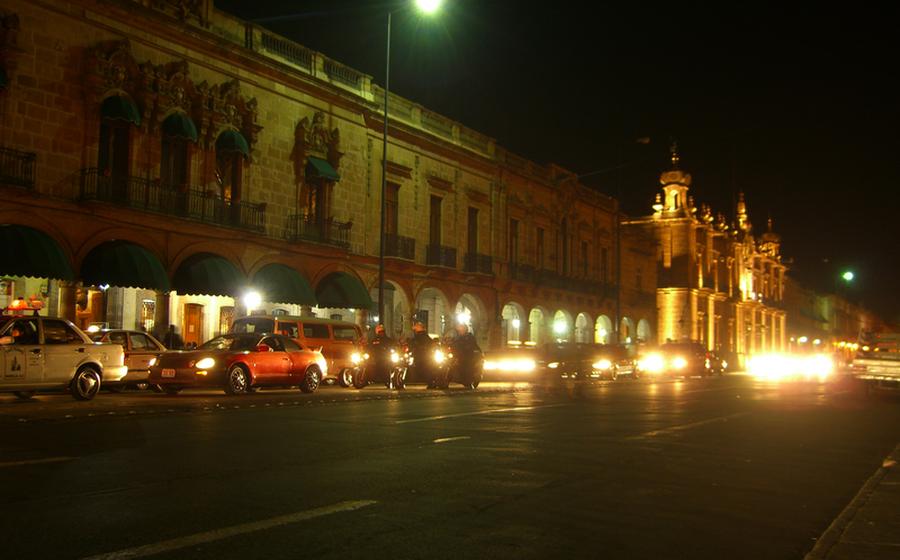
Museo de Arte Colonial
- Morelia's Colonial Charm
- Museo de Arte Colonial: A Journey Through Colonial Art
- Permanent Collection
- Religious Art Highlights
- Secular Art Highlights
- Museo Regional Michoacano
- Guided Tours
- Temporary Exhibitions
- Workshops and Cultural Events
- Museum Shop
- Accessibility
- Location and Transportation
- Hours of Operation
- Admission Fees
Morelia's Colonial Charm
Morelia, the capital of Michoacán, is a city steeped in history and architectural beauty. Founded in 1541, it served as a crucial hub for Spanish colonial rule and retains a remarkable fusion of Spanish and indigenous architectural styles. Its vibrant plazas, colorful buildings, and cobblestone streets have earned it recognition as a UNESCO World Heritage Site. Strolling through Morelia's historic center is like stepping back in time, where the legacy of the past intertwines with the vibrant energy of the present.
Museo de Arte Colonial: A Journey Through Colonial Art
Established in 1 Nicolás, part of the Morelia Cathedral complex. This magnificent museum stands as a testament to the artistic and cultural heritage of Mexico's colonial era. Dedicated to showcasing the finest examples of colonial art, the museum invites visitors to embark on a journey through time, immersing themselves in the masterpieces created during this transformative period.
As you step through the grand entrance, the museum's elegant halls and galleries unfold before you, adorned with an impressive collection of colonial-era paintings, sculptures, and religious artifacts. These artworks, carefully curated and displayed, offer a glimpse into the artistic expressions and beliefs of a bygone era, providing a deeper understanding of Mexico's rich history and cultural identity.
Permanent Collection
The Museo de Arte Colonial boasts an extensive collection of colonial-era paintings, sculptures, and religious artifacts that offer a captivating glimpse into the rich artistic heritage of Mexico. Among the highlights of the collection are works by renowned artists like Miguel Cabrera, José de Ibarra, and Juan Correa, whose masterpieces showcase the mastery and diversity of colonial art. Thematic sections within the museum focus on different art styles and techniques, guiding visitors through the evolution of artistic expression during this period. Whether you're drawn to the vibrant colors and intricate details of oil paintings, the emotive expressions captured in sculptures, or the awe-inspiring grandeur of altarpieces, the Museo de Arte Colonial's permanent collection guarantees an enriching and inspiring journey through the artistic treasures of Mexico's colonial past.
Religious Art Highlights
The Museo de Arte Colonial boasts an impressive collection of religious art that reflects the deep devotion and artistic prowess of colonial Mexico. Oil paintings depicting biblical scenes and saints, executed with meticulous detail and vibrant colors, captivate visitors with their emotive narratives. Exquisitely carved sculptures of saints and angels, rendered in wood, stone, and polychrome, exude a sense of serenity and spiritual transcendence. Ornate altarpieces, adorned with intricate carvings, gilded surfaces, and religious iconography, showcase the mastery of colonial artisans and the grandeur of Catholic worship. These religious artworks, imbued with symbolic and theological meanings, offer a glimpse into the spiritual and cultural life of Mexico during the colonial era.
Secular Art Highlights
The Museo de Arte Colonial boasts an impressive collection of secular art that offers a glimpse into the daily life, landscapes, and historical events of colonial Mexico. Paintings depicting scenes of everyday life, such as markets, festivals, and domestic activities, provide a fascinating window into the past. Landscapes capture the beauty and diversity of Mexico's natural landscapes, from lush forests to arid deserts. Historical paintings commemorate significant events, such as battles, coronations, and religious processions.
One of the highlights of the secular art collection is a series of portraits of notable figures from colonial Mexico. These portraits offer a glimpse into the lives and personalities of some of the most influential people of the era, including viceroys, bishops, and wealthy merchants. The artists' skillful brushstrokes capture the subjects' emotions and expressions, providing a sense of their individuality and character.
The museum also houses a collection of decorative arts from the colonial period, including furniture, ceramics, and textiles. These objects, which were often used in everyday life, showcase the artistic talents of Mexican craftsmen and the fusion of Spanish and indigenous design elements. Visitors can admire intricate wood carvings, colorful talavera pottery, and finely woven textiles that demonstrate the skill and creativity of Mexican artisans.
Museo Regional Michoacano
Housed within the same impressive building as the Museo de Arte Colonial, the Museo Regional Michoacano offers a rich exploration of the history and culture of the state of Michoacan. This museum presents a diverse collection that delves into the region's pre-Hispanic civilizations, showcasing artifacts and exhibits that highlight the indigenous traditions and heritage of Michoacan. Visitors can gain insights into the lives and customs of the Purepecha, Otomi, and Mazahua peoples, who have made significant contributions to the cultural fabric of the region.
In addition to its pre-Hispanic focus, the Museo Regional Michoacano also features exhibits dedicated to the colonial era, providing a comprehensive overview of this transformative period in Michoacan's history. Visitors can explore displays that showcase the impact of Spanish colonization on the region, including the introduction of new technologies, religious practices, and artistic styles. Through interactive exhibits and informative displays, the museum offers a deeper understanding of the complex interactions and cultural exchanges that shaped Michoacan during this time.
Guided Tours
The Museo de Arte Colonial offers guided tours in both Spanish and English, providing visitors with an immersive and informative experience. Advance booking is recommended, especially for groups and those seeking specialized tours. These tours offer a deeper understanding of the artworks, their historical context, and the cultural significance of the museum's collection. Knowledgeable guides lead visitors through the galleries, highlighting key pieces, artistic techniques, and the stories behind the artworks. With their expertise, guides bring the museum's collection to life, making the visit a truly enriching and memorable one. Be sure to inquire about guided tours when planning your visit to the Museo de Arte Colonial.
Temporary Exhibitions
The Museo de Arte Colonial regularly hosts temporary exhibitions that showcase diverse art forms and cultural expressions. These exhibitions often feature collaborations with other museums, galleries, and cultural institutions, both from Mexico and abroad. The museum's curatorial team carefully selects artworks that complement the permanent collection and offer visitors a fresh perspective on Mexican art and history.
Temporary exhibitions cover a wide range of themes, including contemporary art, photography, folk art, and historical artifacts. Past exhibitions have explored the works of renowned Mexican artists such as Frida Kahlo and Diego Rivera, as well as emerging talents from the contemporary art scene. The museum also collaborates with international institutions to bring exhibitions that showcase the artistic traditions of other cultures.
To stay updated on current and upcoming exhibitions, be sure to check the museum's website or social media pages. Temporary exhibitions offer a unique opportunity to experience new perspectives on Mexican art and culture, so make sure to include them in your visit to the Museo de Arte Colonial.
Workshops and Cultural Events
Beyond its permanent and temporary exhibitions, the Museo de Arte Colonial offers a vibrant calendar of workshops and cultural events that delve deeper into the world of Mexican art and history. These events provide an opportunity for visitors to engage with the museum's collection and Mexican culture in a more interactive and hands-on manner.
Workshops typically focus on specific art forms or techniques, allowing participants to learn from experienced artists and create their own works of art. These workshops cover a wide range of topics, such as painting, sculpture, printmaking, and traditional Mexican crafts. Advance registration is recommended, especially for popular workshops, to secure a spot and ensure the availability of materials.
Cultural events at the museum include lectures, concerts, film screenings, and performances that explore various aspects of Mexican history, art, and culture. These events often feature renowned scholars, artists, and musicians who share their insights and expertise with the audience. Some events may require advance registration or a separate admission fee, so it's advisable to check the museum's website or inquire at the information desk for details.
Participating in workshops and cultural events at the Museo de Arte Colonial is a fantastic way to enrich your understanding of Mexican art and culture. These events offer a unique opportunity to learn from experts, engage with the museum's collection in a new way, and create lasting memories of your visit to Morelia.
Museum Shop
The Museo de Arte Colonial boasts an on-site museum shop where visitors can delve into a treasure trove of souvenirs and art-related items. From meticulously crafted books and postcards to exquisite reproductions of colonial masterpieces, the shop offers a diverse selection of mementos that capture the essence of Morelia's rich cultural heritage.
For those seeking unique gifts, the shop showcases an array of locally-made crafts that celebrate the artistry and traditions of Mexico. Hand-woven textiles, vibrant ceramics, and intricate silver jewelry are just a few of the treasures that await visitors. Whether you're looking for a special gift for a loved one or a keepsake to remember your visit, the Museo de Arte Colonial's museum shop is sure to delight and inspire.
Accessibility
The Museo de Arte Colonial is committed to ensuring that all visitors have an enjoyable and accessible experience. The museum is fully wheelchair accessible, with ramps and elevators providing easy access to all levels of the building. Adapted tours and resources are available for visitors with disabilities, ensuring that everyone can learn about and appreciate the museum's collection. To ensure the best possible experience, visitors with disabilities are encouraged to contact the museum staff in advance to discuss any specific needs or requests. The friendly and knowledgeable staff is always ready to assist and accommodate visitors, making sure that everyone can fully immerse themselves in the museum's cultural and historical offerings.
Location and Transportation
The Museo de Arte Colonial is strategically nestled in the heart of Morelia's historic center, a UNESCO World Heritage Site. This prime location allows for convenient exploration, as the museum is easily accessible by foot from various hotels, restaurants, and attractions. If you prefer public transportation, local buses frequently stop nearby, and taxis are readily available. For those arriving by car, ample street parking is available in the vicinity. The museum's central location makes it an ideal starting point for a comprehensive tour of Morelia's captivating colonial architecture, vibrant plazas, and charming cobblestone streets.
Hours of Operation
The Museo de Arte Colonial's doors are open to the public from Tuesday through Sunday, catering to art enthusiasts and curious visitors alike. It welcomes guests with extended hours on weekends, allowing ample time to delve into its artistic treasures. However, on Mondays and major holidays, the museum observes its designated closings, providing its staff with well-deserved respite and ensuring proper maintenance.
It is always advisable to consult the museum's official website or contact them directly for specific hours of operation or any exceptional closures. This proactive step ensures that you can plan your visit seamlessly, avoiding any potential disappointment and maximizing your time in this cultural haven.
Admission Fees
Admission to the Museo de Arte Colonial is very affordable. Adults pay a modest entrance fee, while students and seniors receive discounts. The museum also offers free admission on Sundays and certain holidays. To get the most value for your money, consider purchasing a Morelia City Pass, which grants discounted access to multiple attractions in the city, including the museum.
